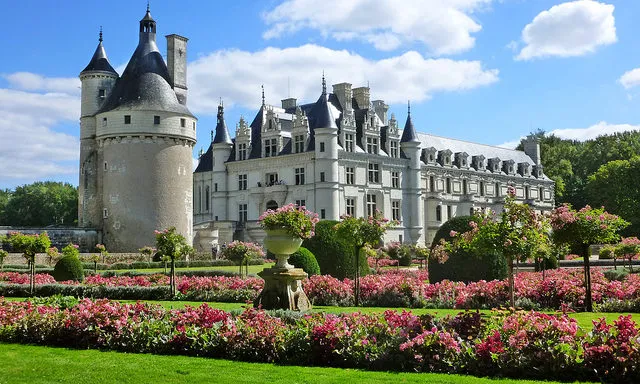
If castles could flirt, Chenonceau would do it flawlessly. It doesn’t shout about its grandeur — it simply shows off in the reflection of the River Cher, and your heart quietly whispers: “Oh, mon dieu…”. That’s how the story begins for everyone who has ever seen this château in real life.
In the heart of the Loire Valley, where historic châteaux compete in elegance, Chenonceau Castle stands out with an unmistakably feminine charisma. Stern kings never ruled here — this was the realm of ladies, and they did it with more grace than any crowned monarch. Diane de Poitiers created the gardens, Catherine de’ Medici added the gallery over the water, and Louise Dupin filled the castle with conversations about philosophy and literature. All this turned Chenonceau into more than just a palace — into a true woman made of stone.
Today, the Ladies’ Castle of Chenonceau is a place where history knows how to smile. You can stroll through its rooms imagining Catherine de’ Medici sneaking a glance at the mirrors to check whether she looks younger than Diane; or sit on the banks of the Cher, where the water gently brushes the arches of the gallery, and think that 16th-century architects understood symmetry better than any Instagram filter.
It smells of wax, old books and roses here — as if time has left the door slightly ajar. Every room speaks in the voice of its mistress: Diane’s chambers are all restrained elegance; Catherine’s are full of opulence with a hint of jealousy; Louise Dupin’s whisper with wit and warmth. Even the air seems to quote Voltaire, who once walked these halls. And when the sun sets, reflecting the façade in the river, it feels as though the castle doesn’t just stand above the water — it sails through the centuries, carrying with it the smile of French history.
A trip here is more than just a guided tour — it’s an encounter with the most charming personality among all the castles of France. You’ll find out how to get to Chenonceau, what not to miss, why it’s called “the Ladies’ Castle” and what other treasures the Loire Valley hides. So pour yourself an imaginary glass of wine, relax and let’s set off on a journey where every step smells of roses and every wall has its own love story to tell.
The history of Chenonceau Castle: from medieval mill to Ladies’ Castle
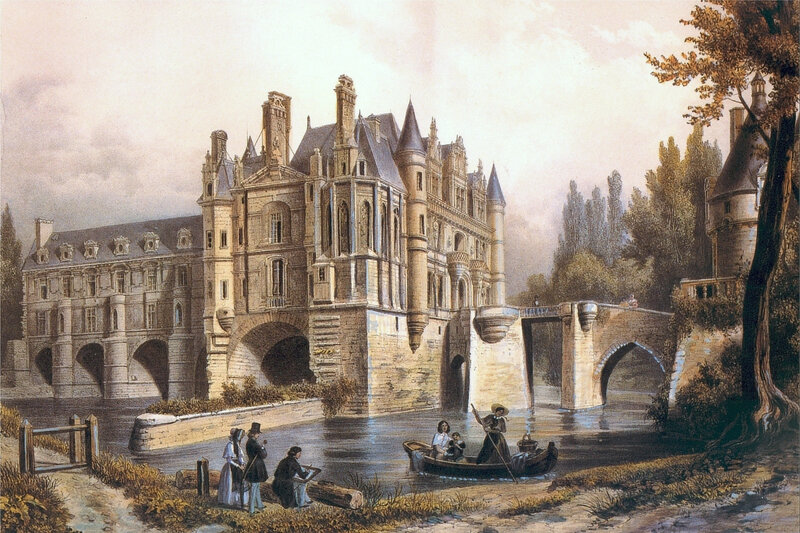
The story of Chenonceau Castle doesn’t begin with kings or court intrigues, but with a modest mill that stood on the River Cher back in the 13th century. It belonged to the Marques family — wealthy merchants who probably had no idea that their estate would one day become one of the jewels of French architecture. The first château was built in 1513 on the remains of the old mill, and that’s when Chenonceau acquired its distinctive “watery” silhouette — as if the palace had grown straight out of the river.
In 1547, the castle came into the hands of Diane de Poitiers — the favourite of King Henry II. She turned Chenonceau into a true oasis of beauty: she laid out a geometric garden, created terraces and built an elegant arch across the river. Diane loved order, symmetry and perfect perspectives — perhaps that’s why her garden is still considered one of the most harmonious in France. But after the king’s death, everything changed: Catherine de’ Medici, Henry’s widow, forced Diane to return the castle and made it her own residence.
Under Catherine, Chenonceau became the beating heart of court life. Balls, masquerades and receptions were held here, and in the mirrored rooms people discussed not only politics but also poetry, fashion and alchemy. It was Catherine who commissioned the famous gallery over the water — a two-storey hall that linked the two parts of the castle and made Chenonceau unique among all the Loire châteaux. This gallery is still the symbol of the site — a kind of bridge between history and art.
From philosophers to war: how Chenonceau survived the centuries
In the 18th century the castle belonged to Louise Dupin, a woman of brilliant intellect and generous heart. She hosted a salon here, frequented by Rousseau, Voltaire and Montesquieu. Legend has it that thanks to her wisdom Chenonceau was not destroyed during the French Revolution: local peasants respected their hostess and never allowed a single pitchfork to touch the castle. In the 20th century Chenonceau once again played an important role — during the First World War it housed a hospital, and during the Second World War the castle literally stood on the line of demarcation: one bank of the Cher was under occupation, the other lay in the free zone. The gallery became a “corridor of freedom” through which people escaped to the south.
- 1513 — construction of the château begins on the site of the old mill.
- 1547–1559 — Diane de Poitiers’ era: the gardens are created and Chenonceau flourishes.
- 1560–1589 — Catherine de’ Medici’s time, when the gallery over the water is built.
- 18th century — age of philosophers and humanists, the period of Louise Dupin.
- 20th century — hospital, refuge and symbol of humanity in wartime.
Architectural and natural highlights of Chenonceau Castle
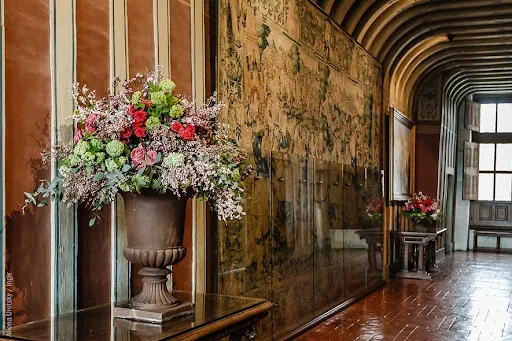
The Ladies’ Castle of Chenonceau is a symphony of stone, water and light. Its architecture is so harmonious that it feels as though it emerged from the River Cher naturally, without human effort. The secret of its beauty lies in the blend of French Renaissance, refined décor and the feminine vision that shaped its appearance over the centuries.
The façade of the castle is built in pale limestone that looks almost pearlescent in the sun. Windows with carved frames, balustrades and spires are reflected in the water, creating perfect symmetry. The interiors are decorated with 16th–17th-century tapestries, carved fireplaces and bouquets of fresh flowers — a tradition the château still keeps today: the floral team creates more than a thousand arrangements a year, adorning every room.
The gallery over the water — a Renaissance marvel
The most famous part of the castle is the two-storey gallery that stretches out across the river. It is about 60 metres long and 6 metres wide, and when you walk along this corridor, it feels as if you are gliding over the water. Windows on both sides open onto the flowing Cher, and every step is accompanied by the soft rustle of waves. In Catherine de’ Medici’s time, balls, masquerades, theatrical performances and even court firework displays were staged here, their reflections dancing in the water like a double illusion of celebration. The gallery served not only as a place of entertainment, but also as a symbol of power — proof that even nature can be bent to the human imagination.
Standing in the middle of the gallery, you see light from the windows scattered across the floor in a pattern that looks like a watery mosaic. In summer it smells of damp stone; in winter you can hear the river whispering its stories through the tiniest gaps. The walls are lined with portraits of monarchs, generals and the very same ladies who once shaped the castle’s destiny. They say that during the First World War beds for wounded soldiers stood here, and during the Second World War people saw “the other side” of France through these very windows, as the river then divided the occupied and free zones. Everyone who walked here could feel it — this is more than architecture; it is a pathway between the past and freedom.
The gardens of Chenonceau — where symmetry meets poetry
The two main garden compositions — Diane de Poitiers’ garden and Catherine de’ Medici’s garden — have been competing in beauty for more than four centuries. Diane’s garden is strict, geometric and calm, focused on perspective and order. Catherine’s is graceful and expressive, filled with the scent of roses, fountains and vibrant colours. Together they create a dialogue of styles — as if the two owners were still debating what the perfect form of beauty should be.
Beyond the château stretches a park and woodland walk, where you’ll find a yew maze, an orangery and a former farm building that now serves as a café. It’s the perfect place to escape the crowds and simply enjoy the moment — with a cup of coffee, silence and the scent of linden trees growing by the water.
- Architectural style: French Renaissance with Gothic elements.
- Stand-out feature: the gallery over the water — the only structure of its kind in the world.
- Materials: local limestone, timber, slate and wrought bronze.
- Gardens: over 130 plant species, 2,000 roses and perfectly clipped formal parterres.
- Modern touch: an on-site floral workshop creates fresh arrangements every day using flowers grown on the estate.
Quick facts about Chenonceau Castle
Chenonceau Castle is one of the main gems of the Loire Valley, and even the French call it “the most feminine castle in France”. Located in the Centre-Val de Loire region, in the Indre-et-Loire department, it stands on the River Cher — this is exactly what makes its silhouette so distinctive. The castle welcomes over a million visitors every year and is considered the second most popular historic attraction in France after the Palace of Versailles.
Chenonceau is easy to visit even on a short trip. The most convenient way to get here is by train from Paris: high-speed TGV to Saint-Pierre-des-Corps or Tours, then a local TER train to Chenonceaux station, which is just a few minutes’ walk from the castle entrance. Travelling by car is just as simple: there is a large free car park nearby, and by the ticket office you’ll find a café and a souvenir shop.
Practical information for visitors
The average visit lasts from two to three hours. That’s enough time to explore the interiors, walk through the gallery over the water, visit the gardens of Diane de Poitiers and Catherine de’ Medici, and enjoy a stroll through the park. In summer there are evening illuminations and flower shows; in winter, themed Christmas decorations transform the atmosphere every year.
- Type of place: historic castle museum and major French tourist attraction.
- Recommended visit time: 2–3 hours (allow at least 1.5 hours for the rooms alone).
- Accessibility level: partially adapted for visitors with reduced mobility.
- Budget: tickets from €16 to €20, with family and student discounts available.
- Best season: April–October — when the gardens are in bloom and the weather is pleasantly mild.
A small tip: if you’d like to avoid the crowds, come early in the morning or towards evening. That’s when the light is softest, the photos turn out the best, and in the courtyard you hear only birdsong and the gentle sound of water beneath the arches.
Fun facts and legends about Chenonceau Castle
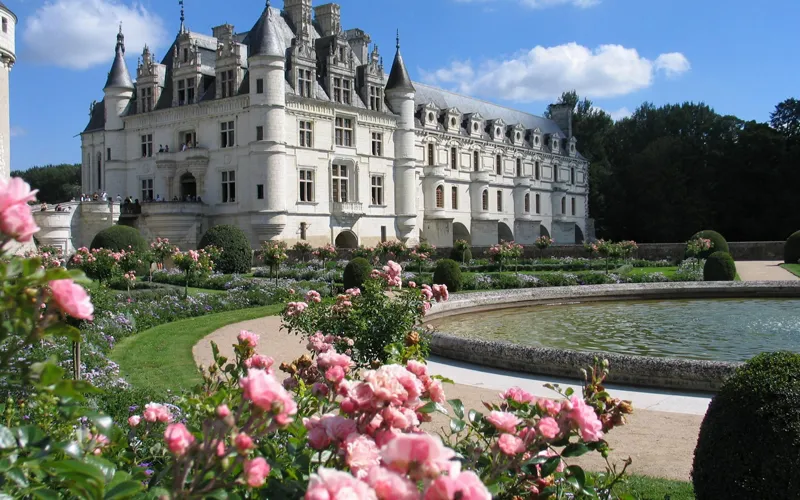
Chenonceau is not just an historic French landmark, but a kind of stage on which very real human dramas have played out. Here you can almost hear the sighs of lovers, the sound of triumph, political intrigues and even the soft rustle of secrets that no one has fully unraveled. Each of its mistresses — from Diane de Poitiers to Louise Dupin — left her own story behind, and together they wove a delicate tapestry where beauty and jealousy, power and tenderness peacefully coexist under one roof.
This castle has worn many faces: at one time a ballroom palace where people danced under shimmering candlelight in silver masks; then a philosophical salon where Rousseau argued with Voltaire about freedom; and later a field hospital where the sound of harps was replaced by the groans of the wounded. And through it all, the castle structure of Chenonceau never lost its beauty. Locals say that this medieval landmark has a woman’s soul: a little mysterious, somewhat changeable and undeniably unpredictable — which is exactly why every visit brings some new discovery.
So before you dive into dates, facts and legends, a little warning: at Chenonceau it’s hard to tell truth from myth. Even when history insists on one version, the walls often whisper something quite different — and much more intriguing.
The legend of the two jealous ladies
The story of Diane de Poitiers and Catherine de’ Medici is perhaps the most famous rivalry of the French Renaissance. They say that while Diane lived at Chenonceau, she ordered the symbols of her power to be carved into the walls — interlaced letters “H” and “D” (Henri and Diane). After the death of Henry II, the jealous Catherine not only drove her rival out, but also ordered those letters to remain, adding a “C” — as if to declare: now it is “Henri, Catherine, Diane”, and everything is under her control. Perhaps that’s why the castle’s façade feels so balanced — even jealousy here takes on an elegant form.
Flowers that never fade
One of the château’s most charming traditions is fresh flowers in every room. The in-house floral workshop, Atelier floral du Château, creates unique compositions that change every week. The idea is said to date back to Catherine de’ Medici, who believed that floral scents could cleanse spaces of “negative spirits” and bring peace to the soul. Today a team of eight florists grows plants directly on the estate — in special greenhouses and gardens where harmony of colour, light and fragrance reigns.
Every time you enter a room, you feel that it “breathes” in its own way: in Catherine de’ Medici’s bedroom the air is thick with lilies; in the library there is a delicate trace of lavender; in the great gallery you’ll notice the freshness of white roses and water. In winter the rooms are decorated with fir branches, clusters of viburnum and candles; in summer — with soft peonies and lilac from the château beds. Each arrangement is handmade, and the florists like to say they don’t just “decorate a space”, they “breathe life into stone”.
Underground passages and the “corridor of freedom”
During the Second World War, the castle literally found itself on the dividing line: the left bank of the Cher was controlled by German troops, while the right bank remained in the free zone. This strange geography turned Chenonceau from a simple historic monument into a thin thread between two worlds. The gallery above the river became a true “bridge to freedom” — used by fugitives, wounded soldiers, diplomats and even artists trying to save their works. At night, footsteps along the wooden floor sounded so softly that it seemed the château itself was helping to conceal the noise.
Locals still pass down the story that guards at the entrance sometimes deliberately turned away, allowing people to slip through. In the darkness you could see only the faint glow of lanterns, and mist rose from the river, wrapping the fugitives in a protective veil, as though nature itself were taking part in the rescue. In the cellars of the castle, documents, letters and even several works of art from Parisian museums were hidden, including part of the Louvre’s collection. After the liberation of France, the estate’s owner, Madame Menier, received official thanks for her courage and humanity — she risked everything, but never closed her doors to those in need of help.
Today visitors walking through the gallery often have no idea that this space was once not only an architectural masterpiece but also a silent witness to the struggle for life and dignity. Perhaps that’s why an almost sacred hush still hangs here — a quiet tribute to those who once had the courage to cross a bridge that led towards freedom.
Chenonceau — the castle without a king
Despite its scale and fame, Chenonceau has never belonged to a king of France. It has always been held in the hands of women — wise, strong, sometimes contradictory, but invariably elegant. From Katherine Briçonnet, who began construction of the castle, to Catherine de’ Medici, who completed it in a triumphant style — they all turned stone into story. Their lives were different, but each wrote a chapter where love, ambition and a refined sense of beauty were tightly interwoven.
That’s why Chenonceau is known as “the Ladies’ Castle” — not only because of the list of its female owners, but because of the spirit of the place itself. There is none of Versailles’ pomp here, nor the chilly grandeur of the Louvre. Instead, there is delicacy, the scent of roses, soft light pouring through the windows and a sense of harmony that only a woman’s touch can create. This is a castle where power smells of perfume and history feels like a breath of silk over stone.
Events and festivals at Chenonceau Castle
Chenonceau Castle lives not only in the past — it has its own calendar, and there is always room for celebration. When the morning mist lifts from the Cher, it feels as though the château wakes up with nature itself, ready for yet another day full of events. Its walls have seen kings, poets and philosophers, but today different characters dance here — tourists, musicians, children with cameras and those simply in love with French beauty. Chenonceau has a way of surprising everyone: one day it is a history museum, the next a theatre stage, and on festive nights a fairy-tale palace lit by hundreds of candles.
The French like to say that this château doesn’t age — it merely changes costumes. In spring it smells of jasmine and roses; in summer it glows golden; in autumn it wraps itself in vines; and in winter it sparkles with garlands. Thanks to this, Chenonceau remains lively, authentic and close to everyone who comes here. Its events are not just cultural happenings, but a continuation of the same story once written by Renaissance women — only now to the soundtrack of the modern world.
Spring Flower Festival
Every April, Chenonceau bursts into bloom with the Fête des Fleurs, a spectacular flower festival. At this time the gardens of Diane de Poitiers and Catherine de’ Medici turn into a sea of colour, and florists from around the world compete to create the most exquisite compositions. Instead of ordinary tours, you can follow floral trails: from fragrant lavender paths to installations in the gallery over the water, where thousands of buds form living carpets. They say that during the festival the air around the castle smells so strongly of roses that even the river seems perfumed.
Night illuminations and concerts
In summer, from June to September, Chenonceau becomes a magical setpiece. During the “Les Nuits Magiques de Chenonceau” evenings, the most beautiful castle in France is lit by hundreds of lanterns whose reflections dance on the water, while classical music flows through the gallery. Visitors stroll along the avenues under a starry sky, enjoying the sound of Debussy and the scent of jasmine. If you are lucky enough to come at this time, you will see the old walls almost breathing with light — it feels as though time has stopped just for you.
Christmas at Chenonceau
Winter at Chenonceau is pure magic. From December onwards, the château is decorated with hundreds of garlands, baubles and candles. Each room receives its own theme: “Catherine’s Christmas”, “Diane’s Sunlit Courtyard”, “Festival of Light”. All decorations are created by the castle’s floral team, and no concept is ever repeated twice. Even the fireplaces seem to burn differently — softly, cosily, like in a home eagerly awaiting its guests. During this period, hot chocolate, French wine and lavender desserts are served on site, so you can literally taste the Christmas spirit.
Special events and exhibitions
Throughout the year, the castle hosts themed exhibitions: Renaissance paintings, historical costume reconstructions and talks about women in French history. Several times a year, chamber music fills the halls, performed by orchestras from Paris and Tours — in the very rooms where Catherine de’ Medici once danced. For children there are interactive quests called “Secrets of the Ladies’ Castle”, where young travellers hunt for ancient symbols and learn history in a playful way.
- Spring — flower festival and the start of guided visits to the gardens.
- Summer — evenings with illuminations, concerts and open-air cinema.
- Autumn — tapestry exhibitions and a wine fair in the château’s cellars.
- Winter — Christmas decorations, festive treats and themed tours.
Every season at Chenonceau is a new chapter in its never-ending story. There is no such thing as “off-season” here: in spring the air smells of promise, in summer — of music, in autumn — of wine and cosiness, and in winter — of celebration and light. Perhaps that’s why it’s so easy to fall in love with this castle — it doesn’t just tell you about the past; it reminds you that true beauty is always alive when it is celebrated.
What to see and do at Chenonceau Castle
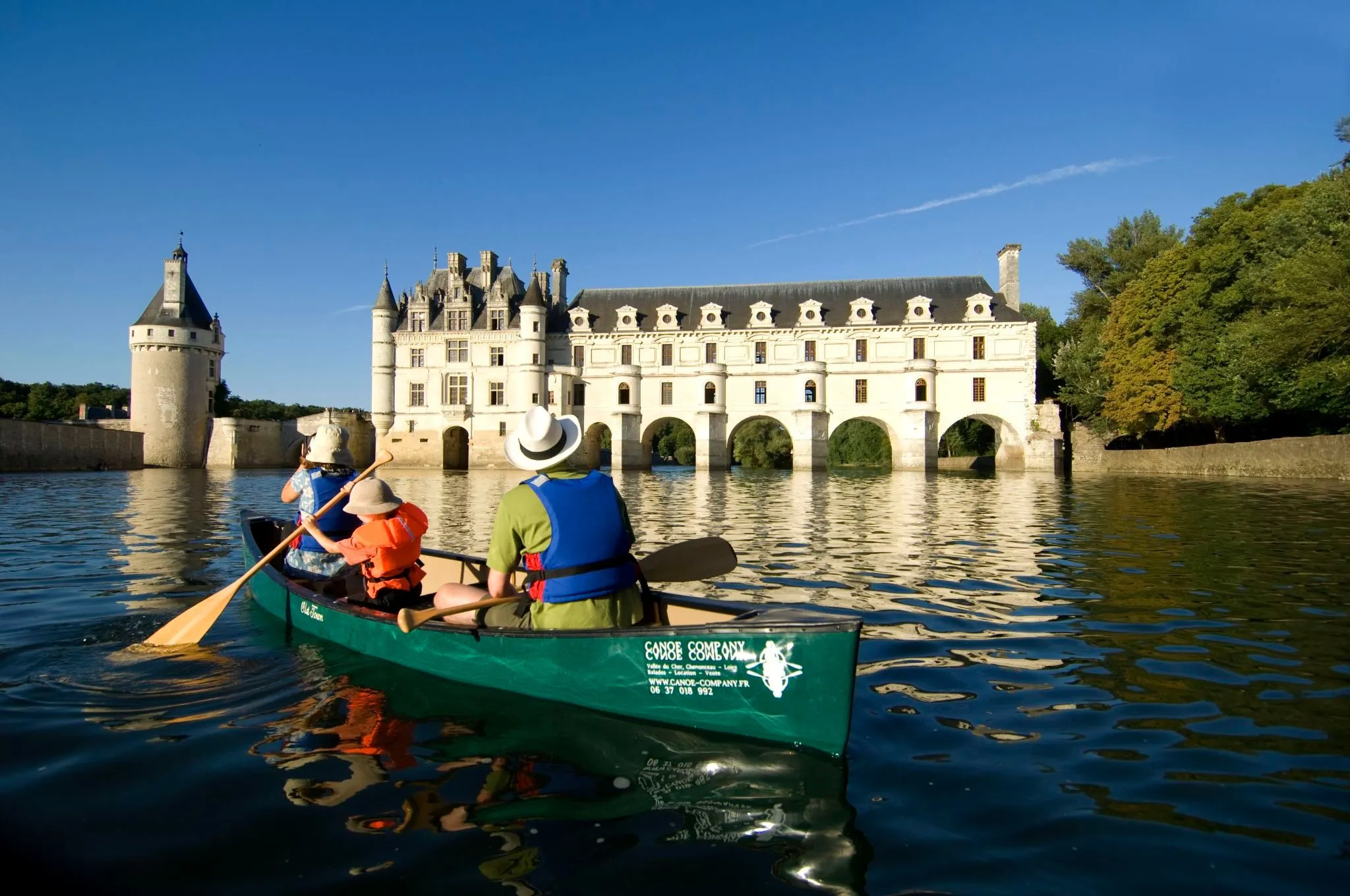
Chenonceau, as a historic estate in the Loire Valley, is often visited in serene silence, with a guide and a camera in hand. It’s the kind of place where you want to lose yourself among mirrors, breathe in the scent of flowers and pretend you’ve just arrived from the 16th century for coffee with Catherine de’ Medici. The French say: “Il faut visiter Chenonceau au moins une fois dans sa vie” — you should visit Chenonceau at least once in your life, or your soul risks never tasting the Renaissance.
Here, history doesn’t sit behind glass; it walks beside you. The maids are long gone, yet it feels as though someone might at any moment set a cup of hot chocolate down on the fireplace. Museum silence gives way to the laughter of tourists, and even the austere hearth in the Guards’ Room seems to sigh with relief — finally, life is back within these walls. You’re not just visiting the Chenonceau museum — you’re a guest in a home where gossip, politics and love long ago merged into a single melody.
A walk through the castle rooms
The Chenonceau tour begins in the entrance hall and the Guards’ Room, where fireplaces from the 16th century and the coats of arms of the families who owned the estate are still preserved. Next you enter Diane de Poitiers’ room — bright, refined, with hunting scenes that recall her energetic character. Then come the sumptuous chambers of Catherine de’ Medici, with dark wall coverings and views over the river. Don’t miss the
Diane’s and Catherine’s gardens
If you think you’ve seen everything, wait until you reach the gardens. The smell of lavender and the sound of fountains work their magic: even the most serious visitors start quoting Rousseau and taking selfies, forgetting they are on an “official tour”. Indeed, the architectural ensemble of Chenonceau has one undeniable talent — it turns even the most punctual tourists into daydreamers. And that, arguably, is its greatest attraction.
The best way to admire the gardens is from the top of the balustrade. Diane de Poitiers’ garden is strict and symmetrical, like a geometric poem. Catherine de’ Medici’s garden, by contrast, is alive and flowing, full of fragrance and colour. Everything here is designed for relaxation: benches in the shade, fountains that quietly murmur and pathways where you can sit for hours watching light change the colours of the petals.
Picnic by the Cher and a boat trip
In the warmer months, a small boat rental centre opens near the park entrance. A short trip along the river lets you see the Chenonceau estate museum from its finest angle — from the water, where its arches appear even more impressive. On the meadow near the farm, picnic tables are set up: French cheese, fresh baguette and a view of the palace over the water — it’s hard to imagine anything more romantic.
- Explore the gallery, gardens, park and farm — they’re all included in the ticket price.
- In summer, boat trips on the Cher are available (up to 45 minutes).
- There is a restaurant on site serving classic French fine dining.
- History enthusiasts can visit the “Women of Chenonceau” exhibition in the former stables.
After a few hours in this palace of ladies and mirrors, you’ll probably take a hundred photos, get lost in the gardens at least three times and whisper “Oh, la la!” at least once. And when you sit down with a glass of wine by the Cher, you’ll realise — this is what French happiness looks like: a little history, a little romance and absolutely no rush. At Chenonceau, as the locals say, even the clocks tick more slowly — just so you have more time to fall in love with this castle of the Loire Valley.
What to visit near Chenonceau Castle
A trip to Chenonceau rarely ends with the castle itself — the surrounding landscapes and nearby towns are simply too tempting. The Loire Valley feels like an open-air exhibition, where every French château has its own personality: one is grand and proud, another dreamy and draped in ivy, a third perfect for a picnic with a baguette and a bottle of wine. The French joke: “si vous avez vu un château, vous n’en avez vu aucun” — if you’ve seen one castle, you haven’t really seen any. And there is, it must be said, some truth in that.
➤ Just a few kilometres from Chenonceau lies Amboise — the town where Leonardo da Vinci once lived and worked. His former home is now a museum with functioning models of his inventions — from the helicopter to the mechanical lion. Even the calmest travellers suddenly start dreaming up their own ideas here, and perhaps feeling just a little jealous of Leonardo.
➤ Further west is Blois, a château that knows more political secrets than any history textbook. It was here that Henry III ordered the assassination of the Duke of Guise, and where Catherine de’ Medici spent her final days. Today everything is peaceful: in the evenings the façade comes to life with light shows, and instead of conspiracies you hear only the tourists’ “wow”. Much safer, but no less spectacular.
➤ A bit further south stands Cheverny — an elegant family estate that inspired the creator of Tintin to imagine Captain Haddock’s Marlinspike Hall. The interiors have preserved the warmth of a lived-in home, and in the courtyard there’s a vast kennel with more than a hundred hunting hounds. The sight is so amusing that even dedicated cat lovers leave with a smile.
➤ If your heart longs for a bit of city buzz, head to Tours. This town of narrow lanes, the Saint-Gatien Cathedral and cafés serving croissants good enough to make you forget your own name is considered the heart of the Touraine region. From here it’s easy to explore the Loire’s major sights, and also to pause for a glass of wine without risking being late for history.
➤ And, of course, don’t miss the Loire wine routes. You can take a bike or a boat and follow the river, tasting Vouvray or Chinon wines along the way. The French say that after the third glass, the scenery becomes even more beautiful — and it’s hard to disagree. This region wasn’t designed for haste; it was made for pleasure — slow, fragrant and pleasantly heady, just like life in France itself.
Tourist facilities at Chenonceau Castle

The Water Palace of the Loire is not just about history — it’s about comfort too. The French understand perfectly that after two hours of beauty, every traveller needs coffee, a toilet and a place to say “oh, la la!” with a clear conscience. That’s why the infrastructure around Chenonceau Castle is designed with the same attention to detail as its interiors.
By the entrance you’ll find a convenient car park, bike racks and an e-bike rental point — the ideal way to ride through the surrounding vineyards. Travellers arriving from further afield will find a small hotel and several family-run gîtes nearby, where the hosts greet you with a smile and homemade croissants. There is even a camping site near Chenonceau for those who prefer sleeping under the stars — the French insist that the Loire sky smells of wine and lavender, and they may well be right.
Inside the grounds, a café overlooks the arches of the gallery and serves a classic menu: cheese, baguette, niçoise salad and, of course, a glass of wine from local vineyards. For gourmets, there’s a restaurant in the old orangery — haute cuisine with a homely warmth. Visitors joke that even in a simple vegetable dish you can somehow taste a hint of the Renaissance.
The souvenir shop sells books, prints, postcards and scented soaps made according to traditional recipes. There is even a perfume called “Chenonceau”, blending hints of rain-washed stone, roses and old pages — as if the castle itself had left a visiting card. Children can enjoy an interactive zone with mini-models, while visitors with reduced mobility benefit from well-placed ramps.
Wi-Fi works reliably, although, in all honesty, it feels almost a shame to switch it on in such surroundings. Still, if you can’t resist and share your photos on social media, don’t be surprised if friends message you: “Are you sure this isn’t a movie set?”. At Chenonceau, even the signal seems to arrive elegantly.
- Parking and bus drop-off — free of charge, right next to the main entrance.
- Wi-Fi throughout the grounds and in the café — no password, and it even reaches the fountain.
- Audio guides in 14 languages, including Ukrainian.
- Step-free access to the gardens, gallery and main floor of the castle.
- Souvenir shop, restaurant, café and children’s area on site.
In short, Chenonceau has thought of everything — from the car park to the wine glass. Here comfort is served with the same grace as dessert in a French restaurant. And the main rule is simple: don’t rush. In France even coffee cools slowly, just to give you time to admire the view and think, “So this is what a perfect day looks like.”
Safety and tips for visiting Chenonceau
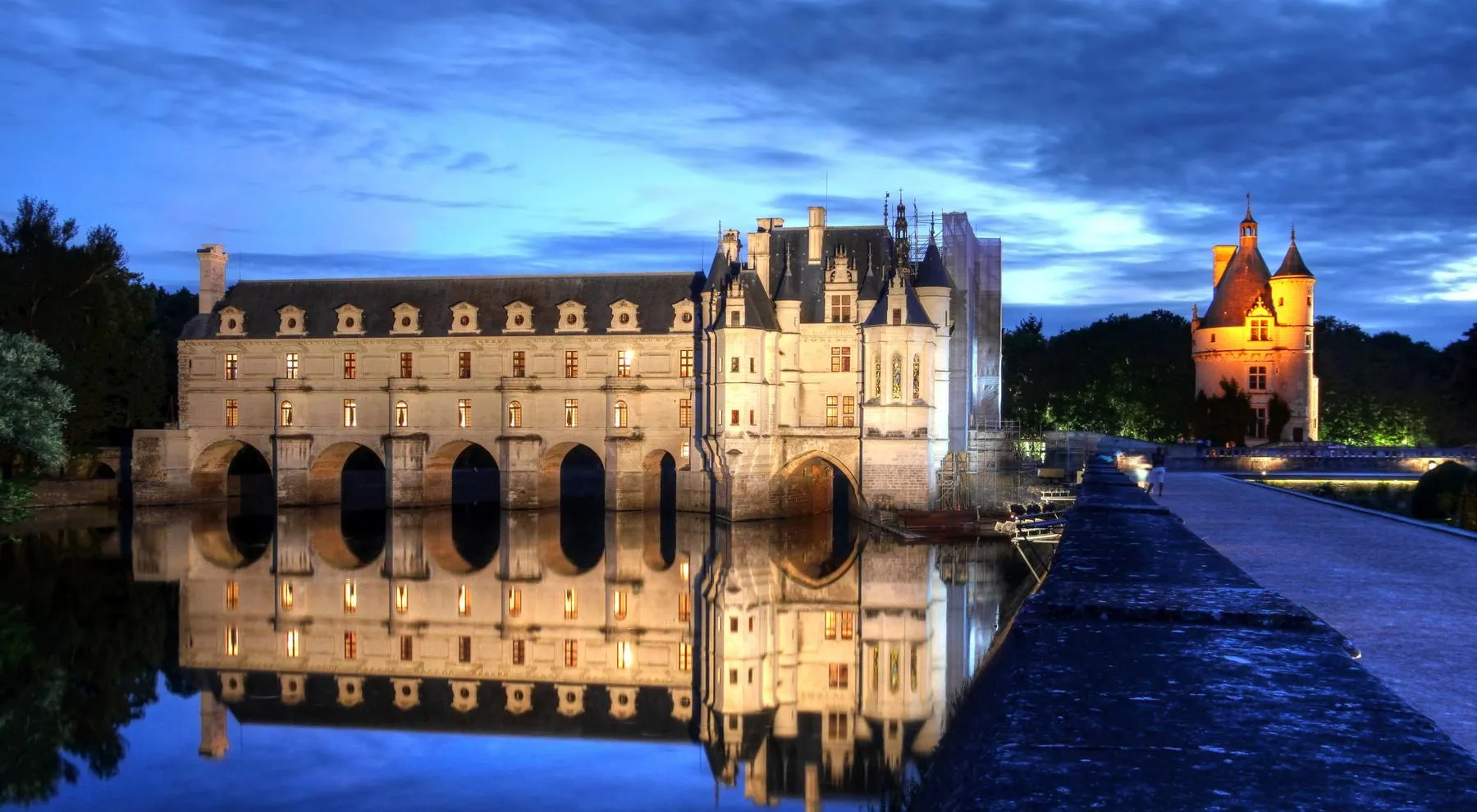
The Renaissance fairy-tale over water that is Chenonceau is a place to unwind — but not to forget basic common sense. It is so peaceful here that even the pigeons seem better mannered than in most cities. Still, to make sure your visit goes smoothly, it’s worth keeping a few simple things in mind.
Firstly, the castle stands directly above the River Cher, so the banks can be slippery after rain. If you’re planning a walk by the water or a boat trip, opt for comfortable shoes — French elegance doesn’t suffer, even if you’re wearing trainers. Inside, the floors are polished like mirrors, so it’s best not to run, even if you’ve just spotted the perfect Instagram shot.
Secondly, don’t leave your belongings unattended — not because it’s dangerous here, but because you’ll then have to explain to the guard in French that “it was the bag with the macarons”. For peace of mind, use the lockers near the entrance — they are free and secure.
In summer, make sure you have a bottle of water, a hat and sunscreen — the gardens of Chenonceau are magnificent, but shade is not guaranteed everywhere. In winter, bring a warm scarf: the castle is built of stone and even the French sun doesn’t always manage to warm the walls.
And one more tip — listen to the staff. They are always polite, but like most French people, they have a special talent for warning you about danger with a smile. If you hear “Attention, madame!”, it’s not a reprimand — it’s a gesture of care. This is where you realise that even safety can sound beautiful in France.
- Wear comfortable shoes, especially for walking through the gardens and along the riverbank.
- Do not lean too far over the gallery railings — the view is just as good from a safe distance.
- Avoid slippery areas after rain, particularly near the river.
- In hot weather — water, hat, sunscreen; in winter — a warm scarf.
- Ask the staff for help — they really do assist, not just point the way.
At this Renaissance treasure of France, even safety seems to carry the scent of calm. Nothing rushes here, and the main advice is simple: stay alert, but don’t forget to enjoy yourself. This feminine château of France doesn’t just teach history — it teaches you to live beautifully, slowly and without stress. If anything is likely to go wrong, it will probably just be your baguette going stale before you’ve had time to finish it.
Frequently asked questions about visiting Chenonceau
What are the opening hours of Chenonceau Castle?
The castle is open every day of the year. In the summer season (from April to October) — from 9:00 to 19:00, and in winter — from 9:30 to 17:00. Last entry is 30 minutes before closing. Hours may change during holidays, so we recommend checking the current schedule on the official website.
How do I get to Chenonceau Castle by public transport?
The easiest way is by train from Paris (Austerlitz station) to Chenonceaux — take a TER train in the direction of Tours or Amboise, with a journey time of around 2 hours. From the railway station it is only a 5-minute walk to the castle entrance. You can also drive via the A10 motorway (about 230 km from Paris).
How much is the entrance ticket to Chenonceau?
An adult ticket costs around €16; children pay about €13, and students and seniors benefit from reduced rates. Online tickets are sometimes cheaper and can help you avoid queues. Family and group passes are also available.
Can I visit the castle with pets?
Yes, but only in special carriers or on a lead in the gardens. Large dogs are not allowed inside the castle, but there are designated areas in the park where you can walk with pets. You can ask the café staff for water for them.
Is photography allowed inside the castle?
Yes, photography is permitted in all rooms, but without flash. The use of drones or tripods is prohibited without special permission from the management. Outdoor photography by the river and in the gardens is completely free.
Are there concerts or special events at the castle?
Yes, throughout the year Chenonceau hosts flower festivals, night illuminations, classical music concerts and Christmas events. The programme of activities is updated annually on the castle’s official website.
Where can I eat near Chenonceau Castle?
Within the castle grounds there is the L’Orangerie restaurant with refined French cuisine, as well as the Le Relais de Chenonceau café serving light meals. In the village of Chenonceaux, near the station, you’ll find several bistros and bakeries with homemade pastries.
Can I visit the castle as part of a Loire Valley tour?
Yes, most Loire Valley tours include Chenonceau on their route along with the châteaux of Amboise, Blois and Cheverny. You can choose a day trip from Tours, Orléans or even Paris.
Can I reach the castle by bicycle?
Yes, the popular cycle route La Loire à Vélo runs along the Loire. Chenonceau has dedicated cycle parking near the entrance, which makes it very convenient to visit as part of a bike tour.
When is the best time to visit Chenonceau Castle?
The best times are spring and autumn, when the gardens are in bloom and there are fewer tourists. In summer the castle is at its liveliest, and in winter it turns into a real Christmas fairy-tale. Choose the season to suit your mood — Chenonceau is beautiful all year round.
Reference information about Chenonceau Castle
Conclusion: Chenonceau — a castle that knows how to love
Chenonceau is not just “another castle on the Loire”. It is a true Pearl of the Loire Valley, managing to combine Renaissance grace, a feminine spirit and that distinctly French ability to laugh gently at its own history. Standing beneath the arches of the gallery, you realise: this is more than architecture — it is a French Venus among châteaux, beautiful without even trying — because this is France, mon ami, where even the stones know how to pose.
If you dream of seeing the most beautiful castles in France, this is the place to start. Chenonceau France is the perfect introduction to the world of French palaces and royal residences, where every room tells a story, every garden whispers a legend and every statue looks at you as if it knows more than the guide. It probably does.
There is a stern grandeur to many medieval castles in France, but Chenonceau is different. It doesn’t try to overwhelm you; it seduces you — slowly, elegantly, confidently… rather like a Frenchman who knows he has both a truffle and a good compliment up his sleeve. No wonder it’s called a Renaissance Residence — everything here is designed to delight, not intimidate.
When you finish your walk, save a hundred photos and at least fifty sighs, a thought will appear: “What if I follow the whole route of the castles of France?”. And it’s the right thought. Because after Chenonceau you want more: more history, more gardens, more châteaux, more France — preferably with a glass of wine in hand and a soft breeze that somehow smells like freedom.
So if you’re looking for a French palace that will steal your heart — here it is. If you want to see what true, understated Renaissance elegance looks like — it’s here. And if you’d like to feel a little like a king or queen — simply walk along the gallery over the Cher and smile. In the Ladies’ Castle of Chenonceau, even tourists seem to shine a little brighter.
The conclusion is simple: come. Because Chenonceau is one of those rare cases where reality is better than the photos, and the legends are just a modest shadow of what awaits you in person.
À bientôt — and may your travels through France be as beautiful as its castles.




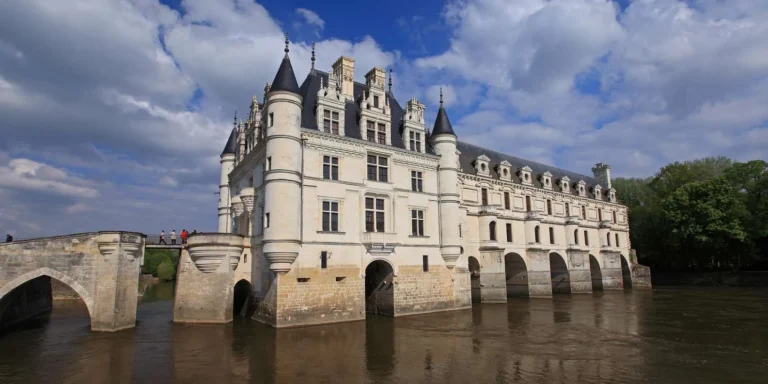



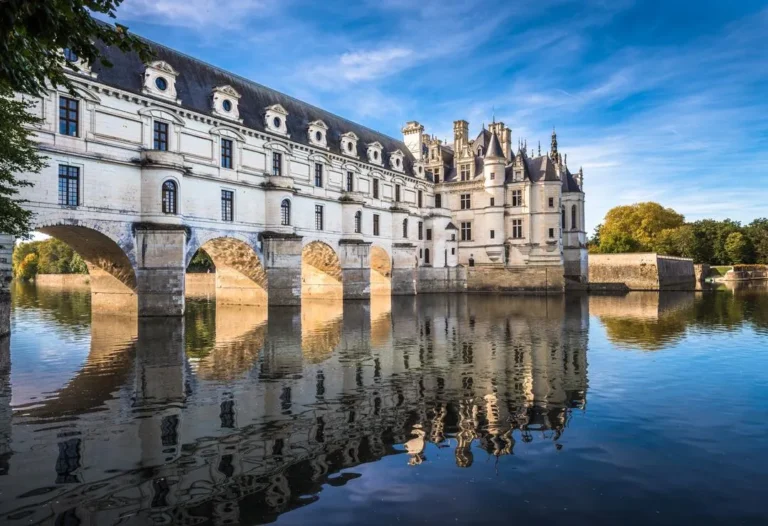
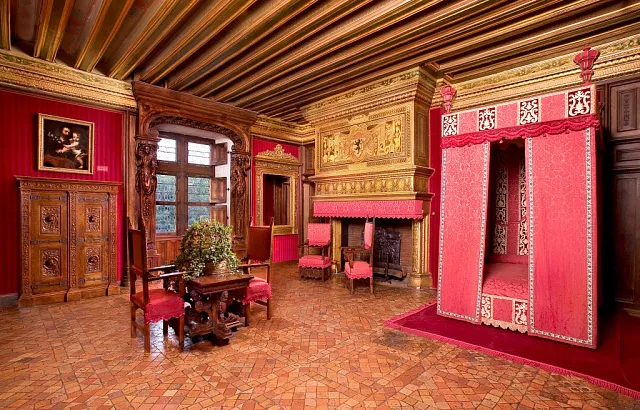
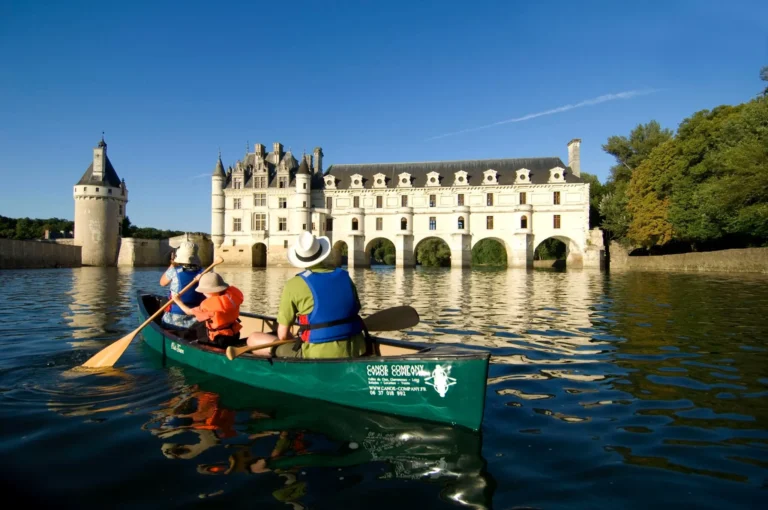


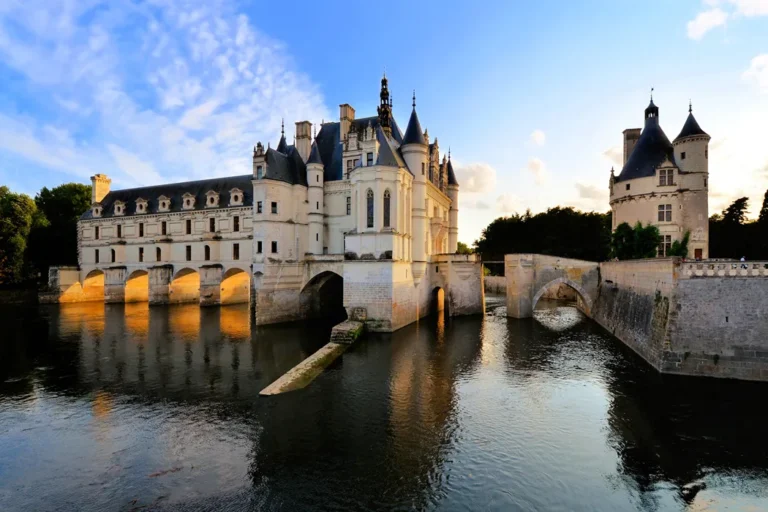
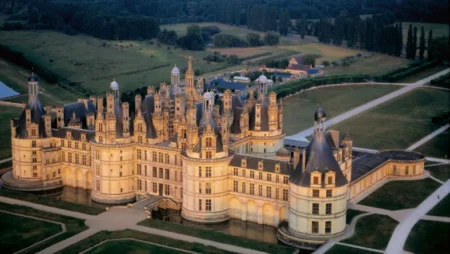
No Comment
You can post first response comment.